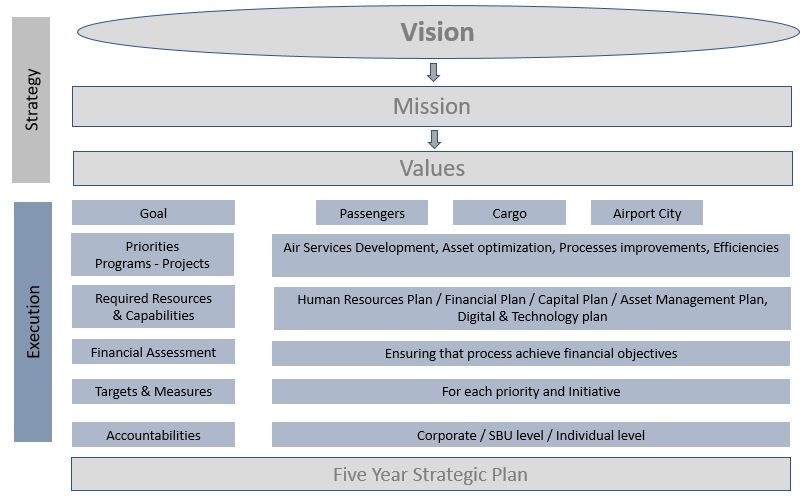We are living in an era of disruption in which new business models are changing the way value is created and delivered. The Aviation industry, and Airports, are not immune to disruption and to be at the leading edge of the curve must consider non-traditional approaches toward Air Service Development, non-aeronautical sources of revenue and non-aviation development. An effective strategy can help Airports carve a competitive edge and effectively compete against Hub and non-Hub Airports within their competitive canvas. Airport Strategy Defined Strategy is simply defined as a high-level plan for achieving Airport goals with available resources. Strategic Planning is the process of defining the strategy, direction or path the Airport wants to take and allocating its resources to achieve its goals. An effective Strategic Plan is crucial to an Airports success because it provides a sense of direction and outlines measurable goals. Strategic Planning is a useful tool for guiding day-to-day decisions and evaluating progress and changing approaches when moving forward. In order to have the best results, an Airport should give careful thought to strategic objectives and then back up these goals with realistic, thoroughly researched, quantifiable benchmarks for evaluating results. While there are dozens of frameworks out there, I have tried to put together a simple and practical framework that can help in aligning an Airports Vision to its Goals, all the way through to identifying individuals’ accountabilities in contributing to the Vision. Airports need to show employees how each team member is crucial to achieving the Vision, irrespective of which department they work in. Strategic frameworks should be simple, practical and well articulated The overall framework can be divided into two parts: Strategy and Execution. The first part is strategic in nature where the Airport goes through a structured process to define a Vision, Mission, and Values for the Airport. The most important of these is Vision as this gives the Airport a clear, comprehensive “photograph” for the future. It provides direction because it describes what characteristics the Airport needs in order to be successful in the future.

A Vision describes WHAT you are trying to achieve in the future. It is the end result of a Strategic Planning process. Some compelling Airport Visions are: · Singapore Changi Airport: Exceptional people. Connecting Lives · Dubai Airports: To always go further and be the world’s leading airport company/ · Adelaide Airport: To be a top tier Airport Business in Asia Pacific, recognised for delivering exceptional outcomes to our customers, partners, shareholders and community. · Edmonton International Airport: More flights to more places The second and most crucial part is the Execution of the Strategic Plan as without proper Execution even the best and most thoughtful Vision and Mission will not bring any tangible value to the Airport. The right Execution starts with setting up tangible and realistic goals in terms of Passengers, Cargo or Aerotropolis/Airport City growth rates. This is also the starting point in which a demand forecast is done based on econometric indicators and incremental growth initiatives taken by the Airport. Based on the demand forecast an Airport then needs to setup its priorities for Air Service Development as to which regions and carriers to target, required peak hour capacity to handle the throughput and passenger experience that needs to be delivered. This is an important phase as an Airport might have quite a lot of opportunities, but this is where an airport has to focus on what is required and not required to achieve its goals. At this stage an Airport might adopt various priorities models to help them sequence out the projects and see what gives the best return on investments. Once the priorities are set, then at an enterprise level an Airport has to evaluate what resources are needed in terms of Capital, Technology, Human Resources etc. One important thing to remember is that Airports should look at the Total Cost of Operations (TCO) rather then just looking at one cost component as this is the foundational element for financial assessment. Airports need to assess the whole Strategic Plan through financial assessment to ensure that the plan is financially viable. An Airport might evaluate the plan to ensure that certain Key Performance Indicators (KPI’s) like EBITDA, Net profit, etc. are met. Once the Strategic Plan has met the financial thresholds, a Scorecard should be created to list the Targets and Measures. The Scorecard acts as a monitoring mechanism for progress and to see if any changes are needed in the plan. Lastly, the Airport must set up accountabilities at the Department and Individual level. This is the last and most important step as it’s people who are going to accomplish the Airports Vision and take it to the next step. To summarise, this simple yet practical Strategic Planning process can help Airports navigate through this era of disruption and carve a competitive edge in becoming one of the world’s leading Airports. I hope this article was helpful. Feel free to contact me if you have any queries or want to discuss further on this. References https://yourbusiness.azcentral.com/strategic-planning-important-organization-4103.html https://changedesignsportal.worldsecuresystems.com/public/organisation/org_strategy/What-are-vision-and-values.html http://www.changiairport.com/corporate/about-us/our-belief.html https://www.adelaideairport.com.au/corporate/about-us/company-profile/vision-mission-values/ http://corporate.flyeia.com/node/10413
